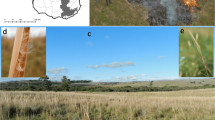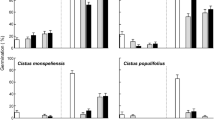Abstract
Ambient temperature and water availability regulate seasonal timing of germination. In fire-prone landscapes, the role of fire-related cues in affecting the range of temperatures and water potentials (ψs) across which germination can occur is poorly known, especially in non-Mediterranean landscapes. We examined interactive effects of temperature (15 or 25°C), ψ (0 to −0.9 MPa), and fire-related cues (heat and smoke) on germination for seeds of three shrub species from fire-prone southeastern Australia. Incubation temperature affected germination of untreated seeds of Kunzea ambigua and Kunzea capitata (Myrtaceae) (reduction at 25°C), but germination was uniformly low in Epacris obtusifolia (Ericaceae). Decreasing ψ reduced germination across both incubation temperatures. Fire cues increased germination at both incubation temperatures and across ψs, although in Kunzea the increase was smaller and occurred over a narrower range of ψs at 25°C. Hydrotime analysis suggested that fire cues reduced the amount of water necessary for germination of Kunzea seeds. Post-fire germination of the three study species may occur during the warm season, although it is reduced and confined to wet periods for the two Kunzea species. Warm season germination of the study species is consistent with a trade-off between the increased risk of failure of a cohort of seedlings, and benefits of early establishment of a cohort that may survive in an environment with aseasonal rainfall.



Similar content being viewed by others
References
Allen PS, Meyer SE, Khan MA (2000) Hydrothermal time as a tool in comparative germination studies. In: Black MJ, Bradford KJ, Vázquez-Ramos J (eds) Seed biology: advances and applications. CABI, New York, pp 401–410
Alvarado V, Bradford KJ (2005) A hydrothermal time analysis of seed dormancy in true (botanical) potato seed. Seed Sci Res 15:77–88
Anderson DR, Burnham KP, Thompson WL (2000) Null hypothesis testing: problems, prevalence, and an alternative. J Wildl Manage 64:912–923
Antonovics J (1976) The input from population genetics: “the new ecological genetics”. Syst Bot 1:233–245
Auld TD (1987) Population dynamics of the shrub Acacia suaveolens (Sm.) Willd.: survivorship throughout the life cycle, a synthesis. Aust J Ecol 12:139–151
Auld TD, Bradstock RA (1996) Soil temperatures after the passage of fire: do they influence the germination of buried seeds? Aust J Ecol 21:106–109
Auld TD, Tozer M (1995) Patterns in emergence of Acacia and Grevillea seedlings after fire. Proc Linn Soc NSW 115:5–15
Auld TD, Keith DA, Bradstock RA (2000) Patterns in longevity of soil seedbanks in the Sydney region of southeastern Australia. Aust J Bot 48:539–548
Baker KS, Steadman KJ, Plummer JA, Merritt DJ, Dixon KW (2005) Dormancy release in Australian fire ephemeral seeds during burial increases germination response to smoke water or heat. Seed Sci Res 15:339–348
Baskin CC, Baskin JM (1998) Seeds: ecology, biogeography and evolution of dormancy and germination. Academic Press, San Diego
Bell DT (1999) The process of germination in Australian species. Aust J Bot 47:475–517
Bell DT, Plummer JA, Taylor SK (1993) Seed germination ecology in southwestern Western Australia. Bot Rev 59:24–73
Berkat O, Briske DD (1982) Water potential evaluation of three germination substrates utilizing polyethylene glycol 20,000. Agron J 74:518–521
Bewley JD, Black M (1994) Seeds: physiology of development and germination. Plenum Press, New York
Bond WJ, van Wilgen BW (1996) Fire and plants. Chapman Hall, London
Bradford KJ (1995) Water relations in seed germination. In: Kigel J, Galili G (eds) Seed development and germination. Dekker, New York, pp 351–396
Bradford KJ (2002) Applications of hydrothermal time to quantifying and modeling seed germination and dormancy. Weed Sci 50:248–260
Bradstock RA, Auld TD (1995) Soil temperatures during bushfires in relation to fire intensity: consequences for legume germination and fire-management in south-eastern Australia. J Appl Ecol 32:76–84
Bradstock RA, Bedward M (1992) Simulation of the effect of season of fire on post-fire seedling emergence of two Banksia species based on long-term rainfall records. Aust J Bot 40:75–88
Bradstock RA, Tozer MG, Keith DA (1997) Effects of high frequency fire on floristic composition and abundance in a fire-prone heathland near Sydney. Aust J Bot 45:641–655
Campbell RK, Sorensen FC (1979) A new basis for characterising germination. J Seed Technol 4:24–34
Carrington ME, Keeley JE (1999) Comparison of post-fire seedling establishment between scrub communities in Mediterranean and non-Mediterranean climate ecosystems. J Ecol 87:1025–1036
Cottingham KL, Lennon JT, Brown BL (2005) Knowing when to draw the line: designing more informative ecological experiments. Front Ecol Environ 3:145–152
de Lange JH, Boucher C (1993) Autoecological studies on Audouinia capitata (Bruniaceae). 8. Role of fire in regeneration. S Afr J Bot 59:188–202
Ellis RH, Covell S, Roberts EH, Summerfield RJ (1986) The influence of temperature on seed germination rate in grain legumes. II. Intraspecific variation in chickpea (Cicer arientinum L.) at constant temperatures. J Exp Bot 37:1503–1515
Finch-Savage WE, Leubner-Metzger G (2006) Seed dormancy and the control of germination. New Phytol 171:501–523
Gilmour CA, Crowden RK, Koutoulis A (2000) Heat shock, smoke and darkness: partner cues in promoting seed germination in Epacris tasmanica (Epacridaceae). Aust J Bot 48:603–609
Gummerson RJ (1986) The effect of constant temperatures and osmotic potentials on the germination of sugar beet. J Exp Bot 37:729–741
Hardegree SP, Emmerich WE (1990) Effect of polyethylene glycol exclusion on water potential of solution-saturated filter paper. Plant Physiol 92:462–465
Harper JL (1967) A Darwinian approach to plant ecology. J Ecol 55:247–270
Hilhorst HWM (1998) The regulation of secondary dormancy. The membrane hypothesis revisited. Seed Sci Res 8:77–90
Huarte R, Benech-Arnold R (2005) Incubation under fluctuating temperatures reduces mean base water potential for seed germination in several non-cultivated species. Seed Sci Res 15:89–97
Keeley JE (1991) Seed germination and life history syndromes in the California chaparral. Bot Rev 57:81–116
Keeley JE, Morton BA, Pedrosa A, Trotter P (1985) Role of allelopathy, heat and charred wood in the germination of chaparral herbs and suffrutescents. J Ecol 73:445–458
Lewontin RC, Cohen D (1969) On population growth in a randomly varying environment. Proc Natl Acad Sci USA 62:1056–1060
Mayer AM, Poljakoff-Mayber A (1989) The germination of seeds. Pergamon, Oxford
McMahon A (1984) The effects of fire regime components in the Little Desert, N.W. Victoria, Australia. In: Dell B (ed) Proceedings of the 4th International Conference on Mediterranean Ecosystems. The Botany Department, University of Western Australia, Nedlands, pp 101–102
Merritt DT, Turner SR, Clarke S, Dixon KW (2007) Seed dormancy and germination stimulation syndromes for Australian temperate species. Aust J Bot 55:336–344
Meyer SE, Allen PS (1999) Ecological genetics of seed germination regulation in Bromus tectorum L. I. Phenotypic variance among and within populations. Oecologia 120:27–34
Michel BE (1983) The evaluation of water potentials of solutions of polyethylene glycol 8000 both in the absence and presence of other solutes. Plant Physiol 72:66–70
Midgley JJ (1989) Season of burn of serotinous fynbos Proteaceae: a critical review and further data. S Afr J Bot 55:165–170
Morrison DA, Morris EC (2000) Pseudoreplication in experimental designs for the manipulation of seed germination experiments. Austral Ecol 25:292–296
Ni BR, Bradford KJ (1993) Germination and dormancy of abscisic acid– and gibberellin–deficient mutant tomato (Lycopersicon esculentum) seeds. Sensitivity of germination to abscisic acid, gibberellin, and water potential. Plant Physiol 101:607–617
Ooi MKJ, Auld TD, Whelan RJ (2004) Delayed post-fire seedling emergence linked to season: a case study with Leucopogon species (Epacridaceae). Plant Ecol 174:183–196
Ooi MKJ, Auld TD, Whelan RJ (2006) Dormancy and the fire-centric focus: germination of three Leucopogon species (Ericaceae) from south-eastern Australia. Ann Bot 98:421–430
Pierce SM, Moll FJ (1994) Germination ecology of six shrubs in fire-prone Cape fynbos. Vegetatio 110:25–41
Purdie RW (1977) Early stages of regeneration after burning in dry sclerophyll vegetation. II. Regeneration by seed germination. Aust J Bot 25:35–46
Roche S, Dixon KW, Pate JS (1998) For everything a season: smoke-induced seed germination and seedling recruitment in a Western Australian Banksia woodland. Aust J Ecol 23:111–120
Schwachtje J, Baldwin IT (2004) Smoke exposure alters endogenous gibberellin and abscisic acid pools and gibberellin sensitivity whilst eliciting germination in the post-fire annual, Nicotiana attenuata. Seed Sci Res 14:51–60
Silva JS, Rego FC, Mazzoleni S (2006) Soil water dynamics after fire in a Portuguese shrubland. Int J Wildland Fire 15:99–111
Skordilis A, Thanos CA (1995) Seed stratification and germination strategy in the Meditteranean pines Pinus brutia and P. halepensis. Seed Sci Res 5:151–160
Specht RL, Rayson P, Jackman ME (1958) Dark Island Heath (Ninety-Mile Plain, South Australia). VI. Pyric succession: Changes in composition, coverage, dry weight and mineral nutrient status. Aust J Bot 6:59–88
Thomas PB, Morris EC, Auld TD (2003) Interactive effects of heat shock and smoke on germination of nine species forming soil seed banks within the Sydney region. Austral Ecol 28:674–683
Thompson K, Ceriana RM, Bakker JP, Bekker RM (2003) Are seed dormancy and persistence in soil related? Seed Sci Res 13:97–100
Tozer MG, Bradstock RA (1997) Factors influencing the establishment of seedlings of the mallee, Eucalyptus luehmanniana (Myrtaceae). Aust J Bot 45:997–1008
Trabaud L (1974) Experimental study on the effects of prescribed burning on a Quercus coccifera L. garrigue: early results. In: Proceedings of the 13th Annual Tall Timbers Fire Ecology Conference, Tallahassee, FL, pp 97–129
Trewavas AJ (1988) Timing and memory processes in seed embryo dormancy–a conceptual paradigm for plant development questions. BioEssays 6:87–92
van Staden J, Brown NAC, Jager AK, Johnson TA (2000) Smoke as a germination cue. Plant Species Biol 15:167–178
Vleeshouwers LM, Bouwmeester HJ, Karssen CM (1995) Redefining seed dormancy: an attempt to integrate physiology and ecology. J Ecol 83:1031–1037
Went FW, Juhren G, Juhren MC (1952) Fire and biotic factors affecting germination. Ecology 33:351–364
Whelan RJ, York J (1998) Post-fire germination of Hakea sericea and Petrophile sessilis after spring burning. Aust J Bot 46:367–376
Acknowledgments
This work was conducted with the financial assistance of an Australian Postgraduate Industry Award to P. B. T., as part of an Australian Research Council SPIRT Grant, and the New South Wales National Parks and Wildlife Service as the industry partner. Editors Russell K. Monson and David A. Pyke improved the manuscript. Experiments comply with the current laws of Australia.
Author information
Authors and Affiliations
Corresponding author
Additional information
Communicated by Dave Pyke.
Electronic supplementary material
Below is the link to the electronic supplementary material.
Rights and permissions
About this article
Cite this article
Thomas, P.B., Morris, E.C., Auld, T.D. et al. The interaction of temperature, water availability and fire cues regulates seed germination in a fire-prone landscape. Oecologia 162, 293–302 (2010). https://doi.org/10.1007/s00442-009-1456-0
Received:
Accepted:
Published:
Issue Date:
DOI: https://doi.org/10.1007/s00442-009-1456-0




